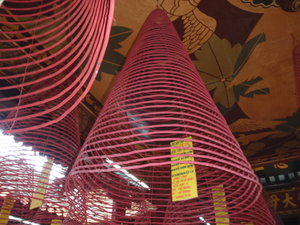Advertisement
Published: December 13th 2010

 Incense Coils
Incense Coils
This is the first day of the lunar month when people burn incense and fake moneyMonday, December 6th
Hoi An
(Sorry that it's taken so long to update my blog. We haven't had an internet connection. We're having a great time though).
Today is the first day of the lunar month - a day when the Vietnamese burn incense and fake money to assist their deceased loved ones in the afterlife. The entire town smelled strongly of incense. We visited the Phuc Kien Pagoda, the assembly hall of the Cantonese Chinese Congregation founded in 1786 and dedicated to the Goddess of the Sea. As we entered, we saw large coils of incense that would burn for 30 days. Each coil had individual dedications attached to them.
Venturing back out to the street, we encountered so many cute children. One little boy about 3 years old is in training to be a super-salesperson. He would pick up boxes of Tiger Balm and offer to sell them to you. If you declined, he returned the box to the stack and waited for his next opportunity. Another little girl ran giggling to her mother. Her laughter was infectious.
We saw women carrying large baskets balanced on their shoulders. An older woman sat in a doorway
selling whistles in the shape of animals. Her teeth were black. Long explained that she sucked on beetle juice many times each day. Not only did the beetle juice turn her teeth black, but it gave her an addictive high.
Continuing on we walked across the 400 year old Japanese Covered Bridge which was built to tame a dragon monster who wagged his tail and caused earthquakes in Japan.
Next we stopped at the Tan Ky House built over 200 years ago. The Tan Ky House is still inhabited by the 5th and 6th generation of one family. The house consists of Chinese, Japanese, and Vietnamese architectural styles. It is built from iron wood - old forest trees that resist termites and destruction from flood waters. Flooding is a frequent occurrence in many of the homes and shops in Hoi An as evidenced by water level markings on first floor columns and walls.
Walking back to our hotel we passed through the central market, an amazing array of vegetables, fruits, flowers, etc. You can buy most anything in these markets including clothes, shoes, spices and perishables. The river here is lined with floating sculptures and lanterns making
this a very colorful and lively area.
Mel was in heaven this afternoon as we visited an organic vegetable farm and had lunch. We learned that each farmer has a plot of land to grow crops. What the family doesn’t consume is sold to the market. A typical farmer in this area makes about $1,500 per year for a family of five persons. The average Vietnamese worker makes about $1,000 per year. Before 1990, the average income was $150 per year. Life expectancy has risen in the past 20 years from an average of 50 years to about 70 years of age. Thirty million motorbikes have been sold since 1990 - prior to that time, owning a bicycle was considered a luxury. Even though the standard of living has vastly improved in the past 20 years since Vietnam opened up, most people have never been on an airplane, elevator, or escalator. In fact rooms on the lower floors in hotels cost more than those on higher levels as they are preferred by the Vietnamese people. Power outages still occur. If you are on a lower floor you can always use the stairs.
Tonight while some members of our

 Happy little girl
Happy little girl
The children are too cute!group attended a cooking school, we ventured out to a restaurant Michelle (one of our travel mates) heard about. The restaurant is called Mango Rooms and the owner/chef named Duc has quite an interesting past. As a boat person, Duc was the only member of his family to get out of Vietnam after the war. He came to the U.S. and wound up in Austin, Texas where he completed school, worked as a dishwasher, became a chef and built quite a reputation for himself. He lived in Europe and South America in addition to several cities in the U.S. Six years ago, Duc decided to return to Vietnam to be closer to his family who live in Hanoi. He settled in Hoi An, opened this amazing restaurant and has done so well he opened a second place called Mango-Mango about two years ago. Duc has cooked for many famous people - Mick Jagger has even eaten at the Mango Rooms! Check out Duc’s website and see what a colorful guy he is.
http://mangorooms.com/video.htm
After eating a fabulous meal of shrimp and duck, we polished off a fabulous banana flambé with mango ice cream for dessert. Yum… We then
walked across the river to introduce ourselves and express our feelings of gastronomical bliss to Duc at the Mango-Mango restaurant. Duc sat and visited for over an hour with us over complimentary drinks. Needless to say we were very happy campers this evening!
Advertisement
Tot: 0.046s; Tpl: 0.012s; cc: 7; qc: 24; dbt: 0.0242s; 1; m:domysql w:travelblog (10.17.0.13); sld: 1;
; mem: 1.1mb
























Diane
non-member comment
Thanks for sharing
Lovely photos. I want to travel there someday.